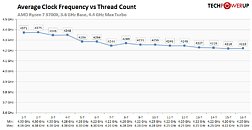- Joined
- Oct 9, 2007
- Messages
- 47,617 (7.45/day)
- Location
- Dublin, Ireland
| System Name | RBMK-1000 |
|---|---|
| Processor | AMD Ryzen 7 5700G |
| Motherboard | Gigabyte B550 AORUS Elite V2 |
| Cooling | DeepCool Gammax L240 V2 |
| Memory | 2x 16GB DDR4-3200 |
| Video Card(s) | Galax RTX 4070 Ti EX |
| Storage | Samsung 990 1TB |
| Display(s) | BenQ 1440p 60 Hz 27-inch |
| Case | Corsair Carbide 100R |
| Audio Device(s) | ASUS SupremeFX S1220A |
| Power Supply | Cooler Master MWE Gold 650W |
| Mouse | ASUS ROG Strix Impact |
| Keyboard | Gamdias Hermes E2 |
| Software | Windows 11 Pro |
AMD over the weekend updated the product-pages of its Ryzen processors on the company website to be very specific about what they mean by "Max Boost Clocks," that are advertised almost as extensively as the processor's main nominal clock-speeds. AMD describes it has "the maximum single-core frequency at which the processor is capable of operating under nominal conditions." We read into this as the highest boost-clock given to one of the cores on the processor.
If you've been reading the "clock-frequency and boost analysis" charts in our processor reviews, you'll know that AMD processors spread their boost frequency progressively across cores during a multi-threaded workload that scales across all cores. At any given time, only one of the cores is awarded the highest boost clock, and while the other cores too get boosted beyond the nominal clock-speeds, they are in slight decrements of 25-50 MHz. The graph below is from our Ryzen 7 3700X review. The second graph below is from our Core i9-9900K review, which too shows only one of the cores getting the max boost frequency, and the remaining cores getting lower boost clocks, although the graph looks flatter.



View at TechPowerUp Main Site
If you've been reading the "clock-frequency and boost analysis" charts in our processor reviews, you'll know that AMD processors spread their boost frequency progressively across cores during a multi-threaded workload that scales across all cores. At any given time, only one of the cores is awarded the highest boost clock, and while the other cores too get boosted beyond the nominal clock-speeds, they are in slight decrements of 25-50 MHz. The graph below is from our Ryzen 7 3700X review. The second graph below is from our Core i9-9900K review, which too shows only one of the cores getting the max boost frequency, and the remaining cores getting lower boost clocks, although the graph looks flatter.



View at TechPowerUp Main Site





